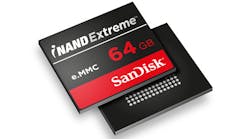SanDisk's iNAND family raises the performance bar with the new iNAND Extreme embedded flash drive (Fig. 1). It targets high end, high performance mobile devices including tablets and smartphones. The internal dual channel memory architecture can move data at 600 Mbytes/s but the external, standard, eMMC 5.0 HS400 interface operates at 400 Mbytes/s.
Related Articles
- The Fundamentals Of Flash Memory Storage
- FRAM With I2C Interface Boasts 1-Mbit Capacity
- HyperBus Accelerates NOR Flash Storage
- How Small A Chip Will A 32-bit Micro Fit In?
These e.MMC chips use SanDisk's 1Ynm NAND die. The iNAND Extreme has optimized RAM support that reduces latency and improves the random access performance. It also has a dual channel CPU interface for supporting two interfaces or faster throughput for a single host.
The iNAND Extreme is available in capacities from 16 Gbytes to 64 Gbytes. Sequential read/write performance is 300/80 Mbytes/s and random read/write speeds are 6000/3000 IOPS.
Part of the performance increase is due to the page-based architecture. This uses smaller blocks that should reduce the internal garbage collection frequency. It also provides a higher and more consistent random write performance compared to conventional e.MMC chips.
SanDisk also incorporated a low latency scheduler that sits between the eMMC 5.0 HS400 interface and the on-chip flash memory. It handles tasks like flash management and data transfers in parallel. This keeps random write latency under 20 ms compared to the competition that has an average upper limit of 80 ms. Typical latency is much lower than both but that is only for a large fraction of operations.


